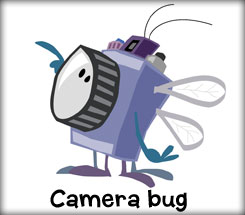Power to the Pixel
- December 3, 2012
- By Michael Kline
 Let’s say it’s a dull winter day. Your students have just come back from lunch and show every sign of a protein-induced stupor. You know the look; lazy eyelids, open mouths, a stare that has no clear resolution or focus, the occasional drooler. And the menu is not to blame. As organic beings, we naturally get comfortable after a good feast (think of lions on an African savannah, bellies bloated and whiskers licked).
Let’s say it’s a dull winter day. Your students have just come back from lunch and show every sign of a protein-induced stupor. You know the look; lazy eyelids, open mouths, a stare that has no clear resolution or focus, the occasional drooler. And the menu is not to blame. As organic beings, we naturally get comfortable after a good feast (think of lions on an African savannah, bellies bloated and whiskers licked).
So, are you looking for something to rouse that bunch of soon-to-be intellectuals? Why not ask them if they know who the Joint Photographic Experts Group is, and why they are largely responsible for most of the information that kids share these days?
For those in the know, the group is actually part of a subcommittee of a subcommittee of a subcommittee (blah blah) of ISO/IEC JTC 1/SC 29/WG 1 that was formed in 1983 to address the concerns of the interaction surrounding digital photography. (Are you getting sleepy yet?) All the 25¢ words aside, their contribution is more well known as the jpg. or jpeg. format for most web-based images–a formula for compressing digital images in order for them to easily be shared.
Which brings up my point. With the effluence of digital cameras (in phones, in iPads, and probably in your eyeglasses and broccoli soon enough) and their inherent cheapness, are you taking advantage of the technology in your classroom? You should be. And because I get paid to give advice–though unsubstantiated–I would be lax in my duties if I didn’t point out some cool ways to engage the pupils of your pupils.
If you haven’t already (and if it meets muster with the admin office), create a classroom Facebook page. It’s free, easy to use, possibly the best way to share photos, and with a little forethought is easily configured to share information only with people you wish to share it with. Rule #1, no last names of any student (ideally, no first names either). Should the school admins squelch the idea of using Facebook, try one of many free online photo sharing services such as Flickr, Picasa, Photobucket, or Pict. And on we go…
Take a photo of each student holding a piece of paper with their name and perhaps a drawing of some activity they like as a form of identification. By the way, if possible, let the students do the picture taking. It’s a great learning opportunity (how to frame a subject, lighting, etc.).
Cut a square hole to one side of a large piece of paper, have the kids fill out their own passport on the page, then snap them with their heads showing through the hole. Be sure to have them be creative!
Have students act out a popular story, take photos in succession (add cutout paper word balloons if necessary), and add them to the Facebook page as an album. As viewers click through the images, the story unfolds.
Ask your students to recreate popular works of art with handmade props and creative lighting (turn off the lights and use a desk lamp if need be). I’m thinking something by Mary Cassat or Michelangelo or DaVinci, and probably not Salvador Dali or Picasso (unless someone in your charge is really good with Photoshop).
Documentation is a very good use of digital photography in that it helps to remember events such as field trips, special events, guest speakers (as in deadly handsome children’s book illustrators… what?). During such times, have someone make placards with the date, location, purpose, and names of those involved, and take photos of those. I find it easier than making notes… LOL!
A friend of mine who is a humanities teacher had her students sketch icons (angel wings, halos, word balloons, butterfly wings, superhero capes, clouds) in chalk on the school’s parking lot, then asked them to lay upon those icons in proper fashion. She then borrowed a ladder and took the shots, with terrific results. BTW, her students names are listed, but no one is actually tagged.
For many more ways to use the camera in the classroom, you can visit the Scholastic.com page 100 Ways to Use Digital Cameras by Gayle Berthiaume. And who knows? Given the chance to be creative behind the eyepiece, perhaps the pupils of one of your pupils will see things a little differently.
Teach. Learn. Enjoy!